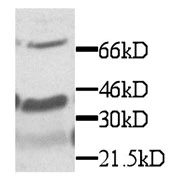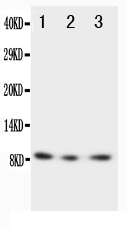CX3CL1 antibody
GTX74237
ApplicationsImmunoFluorescence, ImmunoPrecipitation, Western Blot, ImmunoCytoChemistry, ImmunoHistoChemistry
Product group Antibodies
TargetCX3CL1
Overview
- SupplierGeneTex
- Product NameCX3CL1 antibody
- Delivery Days Customer9
- Application Supplier NoteFor WB: Use at a dilution of 1:1,000 - 1:5,000. For IP: Use at a dilution of 1:300 - 1:800. For IHC: Use at a dilution of 1:100 - 1:500. Optimal dilutions/concentrations should be determined by the researcher.
- ApplicationsImmunoFluorescence, ImmunoPrecipitation, Western Blot, ImmunoCytoChemistry, ImmunoHistoChemistry
- CertificationResearch Use Only
- ClonalityPolyclonal
- Concentration1 mg/ml
- ConjugateUnconjugated
- Gene ID6376
- Target nameCX3CL1
- Target descriptionC-X3-C motif chemokine ligand 1
- Target synonymsABCD-3, C3Xkine, CXC3, CXC3C, NTN, NTT, SCYD1, fractalkine, neurotactin, fractalkine, C-X3-C motif chemokine 1, CX3C membrane-anchored chemokine, chemokine (C-X3-C motif) ligand 1, small inducible cytokine subfamily D (Cys-X3-Cys), member 1 (fractalkine, neurotactin), small inducible cytokine subfamily D (Cys-X3-Cys), member-1, small-inducible cytokine D1
- HostRabbit
- IsotypeIgG
- Protein IDP78423
- Protein NameFractalkine
- Scientific DescriptionThis gene belongs to the CX3C subgroup of chemokines, characterized by the number of amino acids located between the conserved cysteine residues. This is the only member of the CX3C subgroup, which contains three amino acids between cysteine residues, resulting in a Cys-X-X-X-Cys configuration. The encoded protein contains an extended mucin-like stalk with a chemokine domain on top, and exists in both a membrane-anchored form where it acts as a binding molecule, or, in soluble form, as a chemotactic cytokine. The mature form of this protein can be cleaved at the cell surface, yielding different soluble forms that can interact with the G-protein coupled receptor, C-X3-C motif chemokine receptor 1 gene product. This gene plays a role in a wide range of diseases, including cancer, vasculitis, neuropathies, atherosclerosis, inflammatory diseases, and in human immunodeficiency virus infections. [provided by RefSeq, Sep 2017]
- Storage Instruction-20°C or -80°C,2°C to 8°C
- UNSPSC12352203





![WB analysis of 0.25microg of recombinant human Fractalkine using GTX15786 CX3CL1 antibody [4C5]. Dilution : 1:1000](https://www.genetex.com/upload/website/prouct_img/normal/GTX15786/GTX15786_1537_WB_w_23060620_836.webp)


